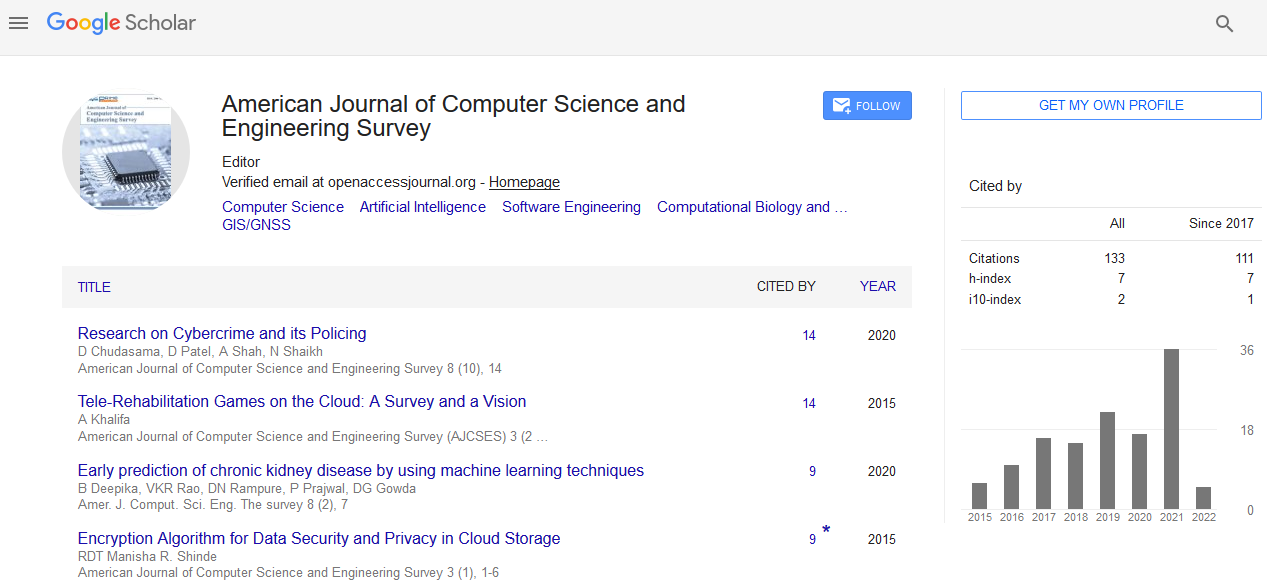Commentary Article - (2022) Volume 10, Issue 1
Electrocardiograms: A Digital Approach to Cardiovascular Diseases
Ahmed Nabih Zaki Rashed*
Department of Electronic and Electrical Communication, Menoufiya University, Egypt
*Correspondence:
Ahmed Nabih Zaki Rashed, Department of Electronic and Electrical Communication, Menoufiya University,
Egypt,
Email:
Received: 03-Jan-2022, Manuscript No. IPACSES-22-12565;
Editor assigned: 05-Jan-2022, Pre QC No. IPACSES-22-12565(PQ);
Reviewed: 19-Jan-2022, QC No. IPACSES-22-12565;
Revised: 24-Jan-2022, Manuscript No. IPACSE-22-12565(R);
Published:
31-Jan-2022, DOI: 10.36846/IPACSES-10.1.4
Description
Cardiovascular infections are among the main sources of
death, and their initial identification and treatment is significant
for bringing down their predominance and death rate.
Electrocardiograms (ECGs) record electrical action of the heart
to give data used to analyze and treat different cardiovascular
sicknesses. Many ways to deal with computer aided ECG investigation
have been performed, including Fourier examination,
head part investigation, breaking down morphological changes,
and AI. Because of the great precision expected of ECG analysis
programming, there is no universally agreed upon calculation
to distinguish P, Q, R, S, and Twaves and measure timespans.
Topological information examination utilizes instruments from
logarithmic geography to evaluate hole like shapes inside information,
and strategies utilizing determination insights and
fractal aspect with AI have been applied to ECG signals with
regards to recognizing arrhythmias inside ongoing years. As
far as anyone is concerned, there doesn’t exist a technique for
recognizing P, Q, S, and Twaves and estimating time periods
which depends on topological elements of the information,
and we propose a clever topological strategy for playing out
these parts of ECG examination. In particular, we lay out rules
to distinguish cardinality minimal and area minimal 1cycles
with specific properties as P, Q, S, and Twaves. This yields a
strategy for estimating the PR interval, QTinterval, STsegment,
QRSduration, Pwave span, and Twave length in Lead II ECG information.
We apply our strategy to 400 arrangements of recreated
Lead II ECG signals and contrast and the stretch qualities
set by the model. Furthermore, the calculation is utilized
to distinguish cardinality minimal and area minimal 1cycles
as P, Q, S, and Twaves in two arrangements of 200 arbitrarily
tested Lead II ECG signs of genuine patients with 11 normal
rhythms. Examination of ideal 1cycles recognized as P, Q, S, and
Twaves and correlation of span estimations shows that 1cycle reproductions can give helpful data about the ECG signal and
could hold utility in describing arrhythmias. Cardiovascular infections
are among the main sources of death because of their
high commonness and death rate. Electrocardiograms (ECGs)
give a harmless proportion of the heart’s electrical action and
are utilized in diagnosing and overseeing different cardiovascular
infections. Along these lines the examination of ECGs is
significant for exact finding and appropriate treatment of cardiovascular
illnesses. A few methodologies 6 to computerized
ECG examination have been performed, including machine
learning, wavelet changes, and steady homology. Because of
the great exactness expected of ECG analysis programming
and the way that the greater part of ECG examination is done
by 10 medical services suppliers, the improvement of calculations
that distinguishes P,Q,R,S, and Twaves, measures timespans,
and additionally identifies arrhythmias is a functioning
area of exploration. Topological information examination (TDA)
is worried about the investigation of shapes built from a dataset
which are invariant under ceaseless disfigurements like extending
and winding. Utilizations of TDA to ECG signals have
utilized industriousness measurements, fractal aspect, and AI.
Involving cycle reproductions has shown utility in different applications
outside of ECG investigation such as breaking down
structures on the nuclear scale and in underlying designing. To
our insight, no one has played out a “backwards” examination
of utilizing data from cycle reproductions to break down ECG
signals. We concentrate on “beat lead 21”, for example lead II,
and for the remainder of the article any reference to an ECG
signal, whether mimicked or genuine, alludes to ECG sign of
lead II. Suppose we are given an n-layered informational collection,
for example a bunch of focuses in R n. There are unmistakable
topological component types related with this dataset:
around of these “types” compare to what exactly is usually
thought of “openings” or “holes” of the 26 distinct aspects in
the informational index.
Acknowledgement
None.
Conflict of Interest
The author declares there is no conflict of interest in publishing
this article.
Copyright: This is an open access article distributed under the terms of the Creative Commons Attribution License, which permits unrestricted use, distribution, and reproduction in any medium, provided the original work is properly cited.

